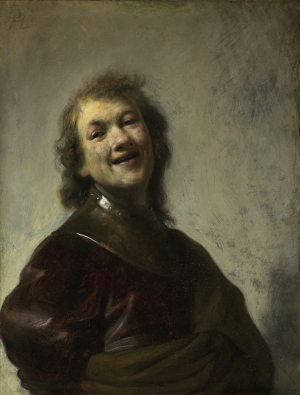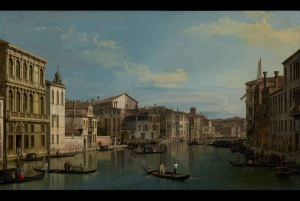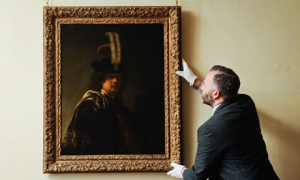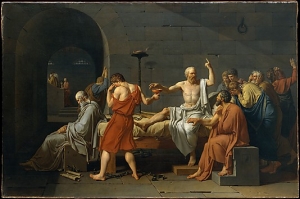|
Displaying items by tag: authentic
A portrait of Rubens’ young daughter Clara Serena, recently deaccessioned by New York’s Metropolitan Museum of Art, is going on display at the Rubenshuis in Antwerp. In 2013, it was auctioned as by a “follower of Rubens”, with an estimate of $20,000-$30,000. Now upgraded as authentic, it will hang in the artist’s own house, in the exhibition “Rubens in Private: the Master Portrays his Family” (March 28-June 28).
The earliest certain provenance of the portrait goes back to a New York collector in the 1930s and it was considered authentic until the American specialist Julius Held downgraded it in 1959.
A painting gifted to the National Trust has been verified as a genuine Rembrandt estimated to be worth £30m.
The self-portrait, which hangs in Devon's Buckland Abbey, had been the subject of debate over its authenticity, since 1968.
Eight months of investigative work at the Hamilton Kerr Institute (HKI) confirmed it was painted by Rembrandt.
The National Trust said extra security measures had been put in place as well as a specially created gallery.
A painting featured on the BBC television program ‘Antiques Roadshow’ has been deemed an authentic work by the 17th century Flemish Baroque master, Anthony Van Dyck. The portrait, which was purchased by Father Jamie MacLeod for $660, is estimated to be worth over $660,000.
Fiona Bruce, the host of ‘Antiques Roadshow,’ suspected that the painting was a Van Dyck during taping. After undergoing a cleaning and restoration, the work was authenticated by Van Dyck expert, Christopher Brown.
Father MacLeod plans to sell the painting and will use the profits to buy new bells for his church.

A painting potentially by the Italian Renaissance master, Leonardo da Vinci, was discovered is a Swiss bank vault holding a private collection of 400 paintings. The work closely resembles a 15th century sketch by da Vinci of the Italian noblewoman Isabella d’Este, which is in the Louvre’s collection. If proven to be authentic, the painting could bring a long-running scholarly debate to a close. For centuries art historians debated whether or not da Vinci went on to paint a version of the sketch of d’Este, one of the most influential figures in art and fashion during her time.
Carlos Pedretti, a professor emeritus of art history at the University of California Los Angeles and a da Vinci expert, told the Italian newspaper Corriere della Sera, “There are no doubts that the portrait is the work of Leonardo. I can immediately recognize da Vinci’s handiwork, particularly in the woman’s face.” Carbon dating conducted at the University of Arizona confirmed with 95% accuracy that the artwork was painted between 1460 and 1650, the time period when da Vinci is believed to have met and sketched d’Este. Further testing indicated that the pigments and primer used in the work match the ones the artist used throughout his career. Some scholars are more hesitant to say that the newly discovered work is an authentic da Vinci as it was painted on canvas rather than wood panels, which were favored by the master.
There are only 15 to 20 artworks in the world that have been properly attributed to da Vinci.

Sunset at Montmajour, a recently discovered painting by Vincent van Gogh, is officially on public view at the Van Gogh Museum in Amsterdam. Axel Ruger, the museum’s director, said, “We are pleased to be able to show this exceptional painting to our visitors, because a new discovery of this magnitude has never before occurred in the history of the Van Gogh Museum.” The work will be on view through January 12, 2014 as part of the exhibition Van Gogh at Work, which shows how in ten years’ time van Gogh developed into a unique artist with an impressive oeuvre.
On September 9, 2013 officials at the Van Gogh Museum announced that after extensive research, they were confident that Sunset at Montmajour was an authentic work by van Gogh. The canvas, which depicts a dry landscape in Van Gogh’s characteristically thick brushstrokes, had been stored for decades in the attic of a Norwegian home before becoming a research subject at the Van Gogh Museum. Scholars were able to trace the earliest history of the provenance of the painting while Oda Van Maanen, the museum’s restorer, used x-ray photos and computer analyses to determine the type of canvas and pigments used, which were consistent with the materials regularly used by Van Gogh. Museum officials had previously deemed Sunset at Montmajour as inauthentic because the artist had not signed it.
Along with Sunset at Montmajour, Van Gogh at Work includes some of the artist’s best-known works including Sunflowers and The Bedroom.

Back in May 2013, the J. Paul Getty Museum in Los Angeles announced that it had bought Rembrandt Laughing, a 17th century self-portrait by the Dutch master, from the London-based art dealer’s Hazlitt Gooden & Fox. On Tuesday, July 16, 2013, it was revealed that Britain’s culture minister, Ed Vaizey, had delayed approval of the Getty’s application for an export license until October 15, 2013, a tactic usually used to give collectors and museums enough time to collect the funds necessary to keep an artwork in the country.
In 2007, Rembrandt Laughing was put up for sale at a small auction house in England and said to be by a “follower of Rembrandt” even though a number of dealers thought it to be an authentic work by the artist. Eventually, scientific tests and studies by a leading Rembrandt scholar confirmed the attribution, causing the work’s value to skyrocket. In order to keep the painting in England past October 15, a British institution interested in buying the work will need to raise around $25.1 million, the price the Getty has agreed to pay for it.
The Getty has run into trouble exporting works out of Britain in the past. In 1994, the institution was told that they could not have Antonio Canova’s sculpture Three Graces, after raising $12 million and waiting five years.

The J. Paul Getty Museum in Los Angeles has acquired two major works of European art -- a self-portrait of Rembrandt (1606-1669) and a view of Venice’s Grand Canal by the Italian painter Canaletto (1697-1768). The portrait, titled Rembrandt Laughing (circa 1628), will round out the Getty’s collection of early works by the artist, which is the finest if its kind in the country.
The portrait of Rembrandt resided in private collections for centuries before appearing on the market in 2007. The work, which was only known through print reproductions, was attributed to a contemporary of Rembrandt until scholarly analysis and scientific testing proved it to be an authentic painting by the Dutch master. One of nearly 40 self-portraits by the artist, Rembrandt Laughing is the only one in which he appears in costume as he appears dressed like a soldier. The painting will be exhibited in the museum’s East Pavilion along with four other Rembrandt works – An Old Man in Military Costume (1630-31), The Abduction of Europa (1632), Daniel and Cyrus Before the Idol Bel (1633), and Saint Bartholomew (1661).
The painting by Canaletto, For the Grand Canal in Venice from Palazzo Flangini to Campo San Marcuola, is a superior work by the artist depicting everyday life in Venice during the 18th century. The painting will be exhibited alongside Francesco Guardi’s (1712-1793) The Grand Canal in Venice with Palazzo Bembo (circa 1768), which features the same stretch of the Grand Canal as Canaletto’s painting.

In 2000, the Denver Art Museum received a painting titled Venice: The Molo from the Bacino di S. Marco from the foundation of a deceased local collector. Covered in grime, the work was attributed to a student of the Italian 18th century painter Giovanni Antonio Canal (1697-1768), better known as Canaletto, and placed in storage.
In 2007, Timothy Standring, the museum’s curator of painting and sculpture, noticed the canvas while doing routine inventory. Standring saw past the layers of discoloration to the masterful brushstrokes and detailed figures that lay beneath the grime. Intrigued, Standring embarked on a Canaletto-based research project that eventually brought him to London to meet with Charles Beddington, a renowned expert on the artist. After their meeting, during which Standring presented a photograph of the painting, Beddington agreed to visit the Denver Art Museum to examine the painting in person.
In January 2012, Beddington arrived in the United States and identified the work as an authentic Canaletto; he also dated the painting 1724, meaning it is one of the artist’s earliest undocumented works. The museum soon received a grant from the European Fine Art Fair Restoration Fund to restore the painting, a job that was delegated to James Squires, the institution’s associate conservator of paintings. Over 100 hours of restoration later, Squire’s uncovered the masterpiece that was there along. The painting, which features a brightly colored Venetian scene, is currently on view at the Denver Art Museum.

In 2010, the UK’s National Trust was given five paintings from the estate of the late Edna, Lady Samuel of Wych Cross, the widow of Harold, Lord Samuel of Wych Cross, a property developer, philanthropist, and prominent art collector. Among the bequest was a portrait of an ornately dressed man believed to be a relatively unremarkable 17th century painting. Although the work bears a signature and date reading “Rembrandt 1635,” experts believed it to be a later copy or the work of one of the Dutch master’s pupils.
The painting, which spent nearly two years in storage, has just been identified as an authentic Rembrandt (1606-1669) self-portrait worth over $30 million. The painting hadn’t been examined since 1968 and recent X-ray analysis along with newly found circumstantial evidence from the Rembrandt Research Project indicates that the work is in fact genuine.
The self-portrait is the only Rembrandt in the National Trust’s collection of 13,500 paintings and will remain on view at Buckland Abbey through the end of tourist season. Once it is taken off view the painting will be undergo a thorough cleaning and further technical analysis. Experts will perform dendrochronology to date the beech panel the work is painted on, the paint will be analyzed, and the painting will be x-rayed again to check for under-drawings.
David Taylor, the National Trust’s curator of paintings and sculpture, expects to have a final confirmation on the painting by early next year.

Thanks to the keen eyes of the Metropolitan Museum of Art’s curators, the institution snapped up an important Old Master drawing at an auction at Swann Galleries for $840 (with premium). The auction, which took place on January 29, 2013, was part of the highly anticipated Old Masters Week in New York.
The drawing was described in the auction catalogue as being from the early 19th century and of French origin. An illustration in brush, black ink, and gray wash of Socrates dying, the drawing was said to be modeled after Jacques-Louis David’s (1748-1825) painting The Death of Socrates, a work that resides in the Met’s permanent collection. The original painting by David was acquired by the museum in 1931 and is among the artist’s greatest works.
As it turns out, the alleged copy, which was given an estimated selling price of $500-$700, was a previously unrecorded preliminary compositional study for David’s painting. Along with the painting, the Met owns a well-developed chalk drawing of The Death of Socrates, which helped the Met’s curators to authenticate the compositional drawing despite differences in setting, positions, and gestures of the figures featured in the painting.
The drawing was acquired by the museum via Katrin Bellinger, a frequent agent for the institution.
|
|
|
|
|